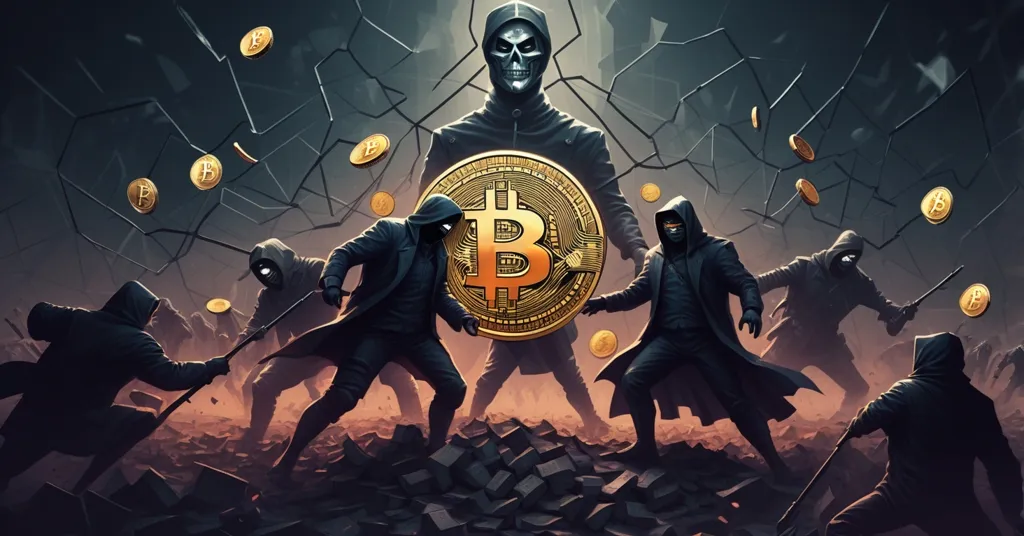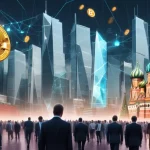Ukraine Sanctions 60 Crypto Firms to Block Russia’s War Funding Channels

War Wallets Exposed: Ukraine Sanctions 60 Crypto Firms to Cripple Russia’s War Funding
Ukraine has launched a fierce crackdown on cryptocurrency’s role in conflict, sanctioning 60 firms accused of bankrolling Russia’s military aggression. Signed into law by President Volodymyr Zelenskyy, this bold strike under Decree No. 465/2025 targets digital financial channels propping up Moscow’s war machine, exposing the murky intersection of blockchain tech and geopolitics.
- Massive Sanctions: 60 crypto firms, with 55 in Russia, hit for aiding war funding.
- Global Strategy: Ukraine pushes for EU and US alignment to seal sanctions loopholes.
- Crypto’s Shadow: Ruble-pegged stablecoin A7A5 moves billions for illicit ends.
Ukraine’s Crypto Crackdown: Cutting the Digital Lifeline
Under the weight of ongoing conflict since Russia’s 2014 annexation of Crimea and the escalated invasion in 2022, Ukraine is fighting not just on the battlefield but in the digital realm. Decree No. 465/2025, signed by Zelenskyy, freezes assets and bans operations of 60 cryptocurrency companies—55 based in Russia and 5 in Cyprus, Kazakhstan, and the UAE. The targets are a mixed bag: 5 crypto exchanges, 19 mining operations, 17 digital asset issuance platforms, and 19 payment or brokerage services. Names like Token Trust Holdings Limited (Cyprus), EXMO RBC Limited (Kazakhstan), AWX Solutions (UAE), Crypto Explorer DMCC (UAE), and Bitpapa IC FZC (UAE)—all already under US sanctions—made the list. On top of that, 73 Russian individuals, including central bank bigwigs, face asset freezes. This isn’t a polite warning; it’s a calculated gut punch to Russia’s financial backdoor, as detailed in reports about Ukraine’s sanctions on crypto operators.
Why crypto? With traditional banking channels barricaded by US and EU sanctions—think SWIFT bans and frozen accounts—Russia has turned to decentralized digital assets to keep the cash flowing. Cryptocurrency offers speed, anonymity, and a way to dodge global oversight, making it a perfect tool for sanctions evasion. Ukraine’s Commissioner for Sanctions Policy, Vladyslav Vlasiuk, hammered home the point: these firms are critical nodes in Russia’s shadow economy, funneling funds for its military-industrial complex. Zelenskyy himself noted that one sanctioned company alone shifted billions since early 2025 to support military needs. That’s not spare change; it’s a damn arsenal, and more on this mechanism can be explored through discussions on Russia’s crypto evasion tactics.
Russia’s Blockchain Backdoor: The A7A5 Scandal
What makes a stablecoin a sanctions evasion powerhouse? Enter A7A5, a ruble-pegged stablecoin that’s become Russia’s go-to for dodging financial barricades. For the uninitiated, a stablecoin is a cryptocurrency tethered to a fiat currency—in this case, the Russian ruble—to keep its value steady. A7A5 has racked up over $9.3 billion in transactions in just four months on the Grinex exchange, despite being backed by a measly $156 million in reserves held at Promsvyazbank, a US-sanctioned Russian state-owned bank tied to the defense sector. With over 12 billion A7A5 tokens circulating, analysts from the Financial Times suggest this volume isn’t organic. A small group of users seems to be recycling tokens to fake liquidity—a magic trick that’d make Houdini jealous. Billions in trades, but where’s the real money? Dive deeper into this with data on A7A5 transaction volumes and reserves.
Reports from the Centre for Information Resilience point to concentrated control behind A7A5’s activity, hinting at geopolitical manipulation over market demand. The stablecoin’s origins in Kyrgyzstan, a nation with a GDP of just $17.5 billion, raise further red flags. Is this tiny economy a legit hub for blockchain innovation, or just a proxy for Russia’s financial shell games? To put that $9.3 billion in perspective, it’s over half of Kyrgyzstan’s entire economic output—hardly a casual figure for a niche digital asset. Add in A7A5’s ties to Promsvyazbank and whispers of involvement from high-profile crypto figures, and you’ve got a recipe for state-backed evasion that’s tough as hell to crack. Learn more about this in an analysis of A7A5’s role in sanctions evasion.
“Ukrainian President Zelensky has sanctioned 60 companies aiding Russia’s sanctions evasion via crypto, including 55 from Russia and others from Cyprus, Kazakhstan, and the UAE. The move targets mining, exchange, and payment firms as Ukraine seeks to block Russia’s growing use of…”
— Wu Blockchain (Twitter post)
A Historical Playbook: Crypto as a Sanctioned State’s Tool
Russia isn’t writing a new script here; it’s riffing on a well-worn playbook. Sanctioned regimes like Iran and North Korea have long leaned on crypto to bypass financial isolation. North Korea, for instance, has funneled ransomware proceeds through Bitcoin for years, using mixers and anonymous wallets to obscure trails. Iran has mined crypto to fund imports under the radar. Since 2014, and especially post-2022, Russia has followed suit, scaling up from niche experiments to strategic operations like A7A5. What started as a workaround for frozen bank accounts has morphed into a lifeline for military spending. Ukraine’s sanctions are a direct counterpunch, but they’re playing catch-up to a game that’s been evolving for a decade. For broader context, check insights on crypto’s role in the Ukraine-Russia conflict.
The Double-Edged Sword of Decentralization
Let’s not dodge the hard truth: cryptocurrency is both a beacon of freedom and a weapon for chaos. As champions of decentralization at Let’s Talk, Bitcoin, we’re all for effective accelerationism—pushing tech forward to disrupt the status quo. Bitcoin’s unassailable code embodies peer-to-peer liberty, untouchable by state overreach. But let’s not kid ourselves; even BTC can be misused, and altcoins or platforms like Ethereum fill gaps Bitcoin shouldn’t. The diversity of blockchain tech is messy but vital—until it’s exploited by war wallets. Ukraine’s crackdown highlights this brutal duality: for every unbanked individual empowered by crypto, there’s a shadowy transaction funding conflict. For a wider perspective, explore how Russia funds conflict using stablecoins like A7A5.
Playing devil’s advocate, could Ukraine’s sanctions backfire? Shutting down 60 firms sounds decisive, but it might just push illicit flows deeper underground. Russia’s already proven it can innovate—A7A5 blends on-chain transparency (transactions visible on the blockchain for anyone to audit) with off-chain opacity (hidden dealings via private ledgers), making enforcement a nightmare. What’s to stop Moscow from pivoting to layer-2 solutions on Ethereum or obscure peer-to-peer platforms Ukraine’s already tracking for high-risk transfers? And let’s not ignore collateral damage. Not every miner or small trader in these firms is a Kremlin stooge. Picture a legit exchange in Kazakhstan, caught in the crossfire, losing everything overnight. Sanctions cut wide, and innocent players bleed too. Bitcoin maximalists might scream, “Stick to BTC, ditch the shady altcoins!” but even they can’t deny crypto’s borderless nature is a double-edged blade.
Global Coordination: Closing the Crypto Loopholes
Ukraine knows it can’t win this alone. Zelenskyy and Vlasiuk are pushing hard for the EU and US to mirror these sanctions, aiming to choke off Russia’s access to friendly jurisdictions or unregulated hubs. Without synchronized action, Moscow can just reroute funds through a lax offshore exchange or a crypto-friendly nation. It’s a noble plan, but crypto’s global sprawl makes this a cat-and-mouse game. Regulators are always three steps behind tech that thrives on evading control. Vlasiuk admits the challenge: varying laws and enforcement gaps mean sanctions are often just a half-measure. Still, aligning with Western allies builds on past efforts—like EU sanctions post-2022—and signals a new front in economic warfare where blockchain is both target and tool. Stay updated with the latest on international coordination for crypto sanctions.
What’s Next for Crypto in Conflict Zones?
Looking ahead, Ukraine’s move is just one skirmish in a broader battle over crypto’s role in global power plays. Russia won’t slow down; if A7A5 gets crushed, expect new stablecoins or hybrid models blending old-school banking with blockchain trickery. The rise of state-backed digital assets isn’t a fluke—it’s the future for sanctioned regimes. Meanwhile, the crypto industry must face its dark underbelly. We’re not blind to the risks of overreach, but ignoring abuse isn’t an option either. How do we balance unstoppable freedom with stopping blatant war funding? That’s the blurry line we’ve got to wrestle with. One thing’s clear: decentralized finance in conflict zones isn’t a sidebar—it’s the main event. For background on the broader sanctions framework, refer to international sanctions during the Russia-Ukraine conflict.
Key Takeaways: Unpacking Ukraine’s Crypto Sanctions
- What triggered Ukraine’s sanctions on 60 crypto firms?
Ukraine acted to disrupt financial channels funding Russia’s military in the ongoing conflict, targeting firms enabling sanctions evasion through digital assets. - How does Russia exploit crypto to bypass sanctions?
Russia uses tools like the ruble-pegged stablecoin A7A5 to shift billions via exchanges like Grinex, dodging traditional financial restrictions with decentralized tech. - What types of crypto entities face Ukraine’s sanctions?
The list includes exchanges, mining operations, digital asset issuers, and payment providers accused of supporting Russia’s war funding efforts. - Why is global coordination critical for these sanctions?
Teaming up with the EU and US helps close jurisdictional gaps, preventing Russia from redirecting funds through unregulated or friendly territories. - What risks do stablecoins like A7A5 bring to conflict zones?
Stablecoins enable rapid, massive transactions with little oversight, risking unchecked funding for illicit activities and undermining international sanctions. - Could Ukraine’s crypto sanctions reshape blockchain regulation?
This crackdown might push for tighter global policies on digital assets, potentially curbing innovation while forcing the industry to address misuse in geopolitics.
Ukraine’s sanctions are a wake-up call, but the road ahead is a slog. Russia’s blockchain maneuvers show no sign of stopping, and hybrid setups blending traditional finance with crypto keep regulators scrambling. For Bitcoin purists, this fuels the fight for a return to peer-to-peer purity, free from state games. For the rest of us, it’s a stark reminder that regulation, however flawed, can’t be shrugged off. If we’re serious about driving adoption responsibly, we’ve got to call out the scams, the evasion, and the outright bullshit while defending the tech that can redefine money. No hype, no shilling—just the raw, messy reality of crypto in a world at war. For further details on the decree, see Ukraine’s 2025 Decree No. 465/2025 impact.



